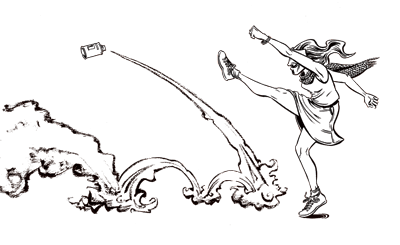
Here’s my illustration for chapter two of Kim Stanley Robinson’s alternate history novel The Years of Rice and Salt, entitled “The Haj in the Heart.” Most of this chapter is set in the 970’s (the Christian 1590’s) and follows Bistami, a Sufi Muslim from Gujarat, India who is saved from marauding thugs by a friendly tiger and later becomes a personal religious adviser to the Mughal Emperor Akbar (another real historical figure). After he falls out of favor with the emperor and his bureaucracy, he is sent on the Haj to Mecca, and proceeds from thence west (chapter two is basically a geographical mirror image of the east-bound chapter one) across northern Africa. Eventually he crosses the straight of Gibraltar to Spain, where an intrepid group of Muslim pioneers have been gradually recolonizing the abandoned European continent and attempting to recreate the golden age of al-Andalus. It is here that Bistami sits in an orange grove with Ibn Ezra, a sort of proto-proto-scientist, in the scene I have chosen to depict.
A debate arises over why the plague happened. An orchard-keeper proposes the common explanation, that Allah killed the Christians because of their wicked and polytheistic ways. Ibn Ezra differs, noting that many Christians in Ethiopia and elsewhere survived, and moreover that the plague killed many Muslims in the Balkans and southern Spain. Instead, he offers a biological explanation. Since he lacks the language of genetics or evolution, Ibn Ezra uses the human-bred oranges (and the naturally occurring fungus that attacks them) as examples to explain how a new, stronger version of plague might arise through cross-breeding. He argues for a less interventionist God, while still remaining within the realm of orthodoxy.
Shortly after this, the Sultana Katima arrives, a sort of proto-proto-feminist character who gets down from her camel unaided. She leads Bistami and a troop of outcasts further north into “Firanja,” where they found a new city (on the ruins of an old city) and construct a progressive, feminist-egalitarian Islamic theology which discards much of the established Hadith.
I was very excited to read today’s entry in my favorite blog of all time, GURNEY JOURNEY, by Dinotopia-creator James Gurney. If you are reading this now, you should definitely go read that next! It’s about models and photo-reference, and how to use them sparingly, and only in the final stages of a piece, so that the imagination isn’t too stifled by an overzealous adherence to observation. Like many of my friends in the comics world, James Gurney is a big advocate of the 1950’s Famous Artist courses and their mannequin-based approach to constructive anatomy. I was pretty late to this party, but I’m proud that I was able to construct all three of these figures from geometric shapes, only sitting on the floor once or twice to figure out where Bistami’s feet should go.



